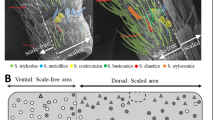Abstract
Recognition of pheromone scent by male insects probably depends on analyzing the blend's composition in terms of relative concentrations of major and minor molecular components. Based on anatomical, physiological and behavioral data concerning certain moth species and the cockroach, we propose a simple, biologically plausible neural circuit which is able to perform this task reliably. The model employs oscillations as a detecting device. This principle is easily generalized to other systems. As a computational device, ratio detection may find applications in a variety of biological situations, e.g. in the olfactory system of all animals.
Similar content being viewed by others
References
Abeles, M. 1982. Local Cortical Circuits, Springer, Berlin.
Bradshaw, J.W., Baker, R., Lisk, J.C. 1983. Separate Orientation and Release Components in a Sex Pheromone, Nature 304: 256–257.
Bertram, R., 1993. A Computational Study of the Effects of Serotonin on a Molluscan Burster Neuron. Biol. Cyb. 59: 257–267.
Boeckh, J., Selsam, P. 1984. Quantitative investigation of the odor specificity of central olfactory neurons in the American cockroach. Chemical Senses, 9, (4):396–380.
Boeckh, J. and Ernst, K.D. 1987. Contribution of single unit analysis in insects to an understanding of olfactory function. J. Comp. Physiol. A161:549–565.
Burrows, M., Boeckh, J., Esslen, J. 1982. Physiological and Morphological Properties of Interneurons in the Deutocerebrum of Male Cockroaches which Respond to Female Pheromone. J. Comp. Physiol. 145:447–457.
Canavier, C.C., Clark, J.W., Byrne, H.H. 1991. Simulation of the Bursting Activity of Neuron R15 in Aplysia: Role of Ionic Currents, Calcium Balance, and Modulatory Transmitters. J. Neurophysiol. 66: 2107–2124.
Changeux, J.P., Danchin, A. 1976. Selective stabilisation of developing synapses as a mechanism for the specification of neuronal networks. Nature (London), 264: 705–712.
Christensen, T.A., Hildebrand, J.G. 1988. Frequency coding by central olfactory neurons in the sphinx moth Manduca sexta. Chemical Senses, 13(1):123–130.
Christensen, T.A., Waldrop, B.R., Harrow, I.D., Hildebrandt, J.G. 1993. Local Interneurons and Information Processing in the Olfactory Glomeruli of the Moth Manduca sexta. J. Comp. Physiol. A 1973 (in press).
Delaney, K.R., Gelperin, A., Fee, M.S., Flores, J.A., Gervais, R., Tank, D.W., Kleinfeld, D. 1993. Waves and Stimulus-Modulated Dynamics in an Oscillatory Olfactory Network, (submitted).
Freeman, W. 1975. Mass action in the nervous system. Academic Press, New York.
Freeman, W.J., Skarda, C.A. 1985. Spatial EEG patterns, nonlinear dynamics and perception: the Neosherrington view. Brain Res. Rev. 10, 147–175.
Gascuel, J., Masson, C., 1987. Influence of olfactory deprivation on synapse frequency in developing antennal lobe of the honeybee. Neurosci. Res. Comm., 1(3): 173–180.
Goodman, C.S., Bastiani, M.J., Due, C.Q., du Lac, S., Helfand, S.L., Kuwada, J.Y., Thomas, J.B. 1984. Cell recognition during neuronal development. Science 225: 1271–1279.
Gray, C., König, P., Engel, A.K., Singer, W. 1989. Oscillatory responses in cat visual cortex exhibit intercolomnar synchronization which reflects global stimulus properties. Nature, vol. 338: 334–337.
Hansson, B.S., Löfstedt, C., Löfqvist, J. 1986. Spatial Arrangement of Different Types of Pheromone Sensitive Sensilla in a Male Moth. Naturwissenschaften 73.
Hansson, B.S., Löfstedt, C. 1987. Inheritance of Olfactory Response to Sex Pheromone Components in Ostrinia nubialis. Naturwissenschaften 74.
Hansson, B., Ljungberg, H., Hallberg, E., Löfstedt, C. Functional specialization of olfactory glomeruli in a moth, Science, 256: 1313–1315, 1992.
Kaissling, K.E. 1987. R.H. Wright Lectures on Insect Olfaction. Simon Fraser University, Burnaby B.C., Canada.
Kaissling, K.E., Kramer, E. 1990. Sensory basis of pheromone-mediated orientation in moths. Verh. Dtsch. Zool. Ges. 83:109–131.
Kerszberg, M. 1989. Genetics and Epigenetics of Neural Function: A Model. J. Cog. Neurosci. 2: 51–57.
Kerszberg, M., Masson, C., 1994. Signal Induced Selection Among Spontaneous Activity Patterns of Bee's Olfactory Glomeruli, submitted.
Li, Z., Hopfield, J.J., 1989. Modeling the Olfactory Bulb and Its Neural Oscillatory Processings. Biological Cybernetics 61:379–392.
Liljenström, H., 1991. Modeling the dynamics of olfactory cortex using simplified network units and realistic architecture. Intern. J. Neural Syst., Vol 2, Nos 1 & 2, 1–15.
Linn, C.E., Campbell, M.G., Roelofs, W.L. 1986. Male Moth Sensitivity to Multicomponent Pheromones: Critical Role of Female-Released Blend in Determining the Functional Role of Components and Active Space of the Pheromone, J. Chem. Ecol. 12:659–668.
Linster, C., Masson, C., Kerszberg, M., Personnaz, L., Dreyfus, G. 1993a. Computational diversity in a formal model of the insect macroglomerulus, Neural Computation, 5:239–252.
Linster, C., Marsan, D., Masson, C., Kerszberg, M., Personnaz, L., Dreyfus, G. 1993b. A Formal Model of the Insect Olfactory Macroglomerulus: Simulations and Analytical Results. in Advances in Neural Information Processing Systems 5, Giles, C.L., Hanson, S.J., and Cowan, J.D. (eds), San Mateo, CA: Morgan Kaufmann Publishers.
Llinas, R., Yarom, Y. 1981. Properties and Distribution of Ionic Conductances Generating Electroresponsiveness of Mammalian Inferior Olivary Neurones in vitro. J. Physiol. Lond. 315: 569–84.
Masson, C., Mustaparta, H. 1990. Chemical Information Processing in the Olfactory System of Insects. Physiol. Reviews 70(1):199–245.
Purves, D., Voydovic, J.T., Magrassi, L., Yawo, H. 1987. Nerve terminal remodeling in living mice by repeated examination of the same neuron. Science, 238: 1122–1126.
Rospars, J.P., 1988. Structure and development of the insect antennodeutocerebral system. Int. J. Insect Morphol. & Embryol. 17: 234–294.
Schweitzer, E.S., Sanes, J.R., Hildebrand, J.G. 1976. Ontogeny of electroantennogarm responses in the moth Manduca sexta. J. Insect Physiol. 22:955–960.
Sun, X., Fonta, C., Masson, C., 1993. Odour quality processing by bee antennal lobe interneurones. Chemical Senses (in press).
Wilson, M.A., Bower, J.M. 1988. A computer simulation of olfactory cortex with functional implications for storage and retrieval of olfactory information. In Neural Information Processing Systems. Anderson, D.Z. (ed) American Institute of Physics: 114–126.
Author information
Authors and Affiliations
Rights and permissions
About this article
Cite this article
Linster, C., Kerszberg, M. & Masson, C. How neurons may compute: The case of insect sexual pheromone discrimination. J Comput Neurosci 1, 231–238 (1994). https://doi.org/10.1007/BF00961735
Received:
Revised:
Accepted:
Issue Date:
DOI: https://doi.org/10.1007/BF00961735




